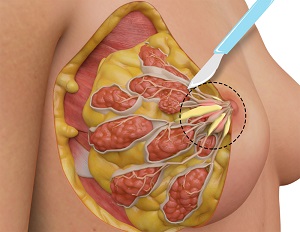
What is Central Duct Excision?
Central Duct Excision is surgery to remove milk ducts in the breast to treat mammary duct ectasia and periductal mastitis. Surgery to remove one or more milk ducts may be performed for such conditions. Removal of one milk duct is known as Microdochectomy, and removal of all the milk ducts around the nipple is known as total or central duct excision.
Mammary duct ectasia and periductal mastitis are benign (non-cancerous) conditions of the breast causing sepsis (infection) of the periareolar tissue of the breast (the dark tissue around your nipple).
Mammary Duct Ectasia
This condition occurs due to the accumulation of fluid in the milk duct, resulting in widening and thickening of the duct. It is characterised by green, bloody, black or dirty-white nipple discharge, with the nipple turned inward. You will need surgery if antibiotics do not work to treat this condition.
Periductal Mastitis
In this condition, the milk ducts are infected and inflamed. It is characterised by nipple discharge, which may or may not be bloody. A lump is eventually formed, which can be felt by touching.
Surgical Procedure for Central Duct Excision
Surgery for central duct excision is usually followed by breast reconstruction surgery.
Before surgery, your surgeon may prescribe certain medicines and instruct you to not eat or drink after midnight the night before the surgery. Your doctor may order certain blood tests to be collected before surgery. Your blood pressure and heart ECG are noted.
The surgery involves the following steps:
- You are given general anaesthesia so you will be asleep.
- An incision is made around the areolar edge of your nipple.
- Surgery involves removal of the nipple-areolar complex including the breast tissue up to the muscle pectoral fascia.
- Reconstruction of the breast will be performed by the breast reconstructive surgeons.
- Sutures will be used to create a cylindrical mass.
- Your wound will be dressed with a waterproof dressing.
- Nipple reconstruction and nipple-areola complex tattooing will be performed after 10 months.
Breast Reconstruction Surgery
Most women prefer breast reconstruction following duct excision surgery. This may be performed by a flap surgery which involves surgically removing a section of tissue from another part of your body, typically a muscle flap from your back, to reconstruct your breast.
Sometimes, your surgeon may prefer a two-stage surgery, which may involve placing an expander to stretch the tissue, followed by delayed reconstruction surgery.
Safety Measures to be Followed after Central Duct Excision Surgery
- Take your pain medicines and other medications as prescribed by your surgeon.
- Once you get back home, you can take a shower.
- Wear a bra for comfort and support.
- Do not lift heavy objects or perform stretching exercises until your surgeon approves.
- You may need to rest for a few days after which you will feel comfortable enough to get back to work.
- Follow up with your surgeon regularly as part of the recovery process.
Advantages and Disadvantages of Central Duct Excision
Advantages: Central duct excision relieves the patient from mammary duct ectasia or periductal mastitis followed by reconstruction to retain the shape and form of the breast.
Disadvantages: There are very few disadvantages reported by some patients undergoing this surgery such as excess tissue in the axilla. Infection occurs if immediate nipple reconstruction is performed followed by nipple areolar complex tattooing.
